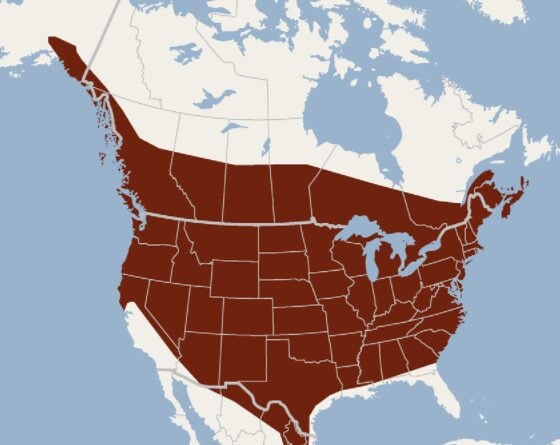5 Types of Bats In Manitoba! (ID GUIDE)
How can anyone in Manitoba think that bats are scary?

Despite what you see in the movies, these fascinating flying mammals wouldn’t hurt a fly! Well, technically, they would hurt a fly, or a mosquito, or a moth. But other than that, bats are harmless. 🙂
It’s hard to believe the diversity and amount of bat species that can be found in Manitoba! But, unfortunately, when you see a bat, it’s typically pretty difficult to determine which kind it is. These nocturnal creatures fly incredibly fast and are only active at night.
5 kinds of bats in Manitoba:
#1. Big Brown Bat
- Eptesicus fuscus

- It is a larger bat with around a 12-inch (30 cm) wingspan.
- Brown fur with black ears, wings, and feet. Wings are hairless.
Big Brown Bats are among the most common bats in Manitoba.
If you look, you’ll find these bats inside caves, tunnels, or other human structures.
Big Brown Bat Range Map
This nocturnal bat primarily eats insects, especially ones that fly at night. However, their preference is to eat beetles.
The Cucumber Beetle is their favorite, which benefits farmers because these insects are terrible pests for agriculture. Many farmers in Manitoba even use bat boxes to attract Big Brown Bats to their property!
Interestingly, many Big Brown Bats have immunity to rabies. Researchers discovered that these rabies antibodies get passed down from generation to generation!

#2. Hoary Bat
- Lasiurus cinereus

- Brown hair with grayish-white tips. Wings and belly are brown and hairless, with a wingspan of approximately 15.5 inches (39 cm).
- Males are almost double the size of females.
You’ll typically find Hoary Bats in Manitoba roosting on trees in woodland forests. They are solitary bats that roost in open foliage. They do form “flocks” when migrating south in late summer, but they don’t hang out with other bats normally.
Hoary Bat Range Map
This species prefers to hunt for prey while flying over wide-open areas or lakes. Hoary Bats hunt alone and enjoy eating moths. They’re known to travel up to 24 miles (39 km) in a single night to gather food!
Though the Hoary Bat is not endangered, it does suffer a loss in numbers because of wind turbines. Hoarys migrate each year back and forth from North America to Central America, and it’s thought that they confuse the wind turbine with a tree as they seek a place to rest.
#3. Silver-haired Bat
- Lasionycteris noctivagans

- Medium-sized with a flathead. The upper part of the tail is covered in thick fur.
- Mostly black all over with white tips on hairs, with a wingspan of approximately 11.5 inches (29 cm).
This species is known to fly more slowly than other bats in Manitoba.
Look for Silver-haired Bats in forests inside tree cavities or bark crevices. They’ve also been known to seek shelter in outbuildings.
Silver-haired Bat Range Map
Silver-haired Bats hunt for soft-bodied insects, such as moths. Interestingly, they also eat a lot of spiders. They accomplish this feat by foraging low to the ground to find food, unlike many other bats.
#4. Little Brown Bat
- Myotis lucifugus

- Glossy brown fur on the body. Wings are hairless and black, with a wingspan of approximately 10 inches (25 cm).
- Despite its name, it has no connection to the Big Brown Bat.
Look for the Little Brown Bat roosting in Manitoba in sheltered places such as human structures, woodpiles, tree hollows, and occasionally caves.
You can even attract Little Brown Bats to your yard! Many people put up bat houses to attract them to their property to control pests like mosquitos or insects that harm crops.
- RELATED: The 7 BEST Bat Houses For Sale! (All price ranges)
Little Brown Bat Range Map

Distribution of all little brown bat subspecies: M. l. lucifugus (red), M. l. pernox (green), M. l. alascensis (blue), M. l. carissima (yellow), M. l. relictus (gray)
Little Brown Bats only have a few natural predators, like owls or raccoons. Unfortunately, most of their mortality is caused by parasites or White-nose syndrome.
White-nose syndrome is a fungal disease that grows around the bats’ mouths, ears, and wings. This illness is spread during hibernation and is responsible for the loss of over one million Little Brown Bats between 2006 and 2011. As of 2018, the Little Brown Bat is an endangered species.
#5. Northern Long-eared Bat
- Myotis septentrionalis

- Fur and wing membranes are tan, with black ears and black wings: long tail and a wingspan up to 10 inches (25 cm).
- Look for their long, pointed ears.
- Also called the Northern Myotis.
Northern Long-eared Bats are found in Manitoba in forested habitats with spruce and pine trees. They typically roost in trees during the summer and switch to a new roost every other day. In the fall, these bats migrate to caves to hibernate with other species of bats.
Northern Long-eared Bat Range Map
Northern Long-eared Bats have incredibly accurate echolocation calls, which helps them navigate their dense forest environments.
Unlike most bats, Northern Long-eared Bats capture their prey by plucking them from a surface rather than catching them in flight. They eat insects, with moths being their favorite.
Sadly, the Northern Long-eared Bat has been threatened by White-nose syndrome, a fungal disease that kills many bats. This disease has decreased their population by 99%. Click play to learn more below!

Do you need additional help identifying bats in Manitoba?
If so, this field guide should be able to help you.
Which of these bats have you seen before in Manitoba?
Leave a comment below!
Check out my other guides about animals in Manitoba!
-
Owl Species That Live in Manitoba!
-
Common Spiders Found in Manitoba! (Includes venomous species)
-
Common Butterflies Found in Manitoba!





